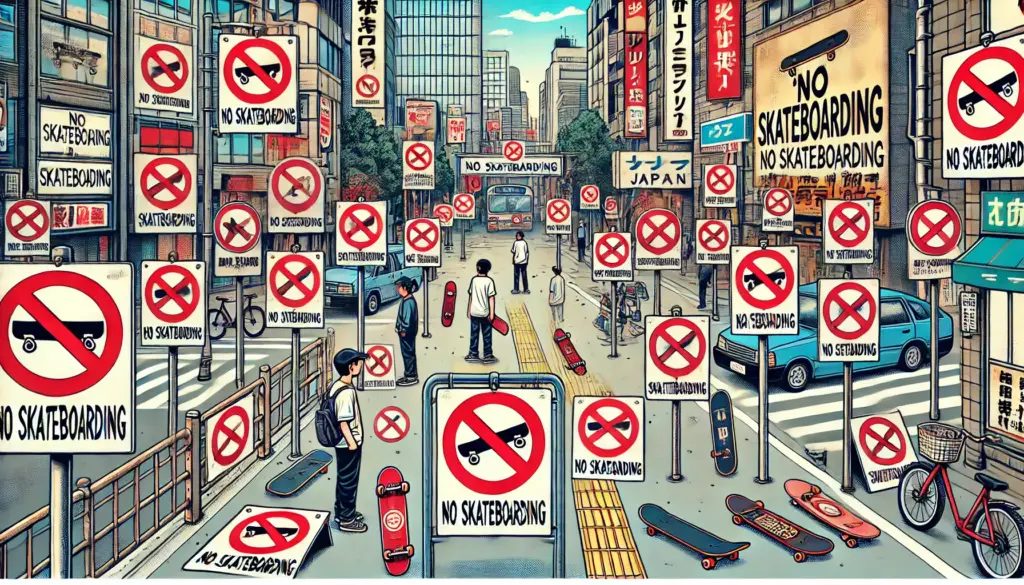
As of July 27, 2025, Japan remains a paradoxical place for skateboarders. Despite the sport gaining international recognition—especially after its Olympic debut in Tokyo 2020—skaters in Japan still face significant hurdles. From legal restrictions to societal stigma, Japan’s infrastructure and culture often lag behind its enthusiasm for sporting success.
In this article, we’ll explore why skateboarding is still treated coldly in Japan, what the Road Traffic Act says about it, and whether the country can catch up with the rest of the world when it comes to supporting this growing sport.
🏆 From Rebellion to Olympic Glory
Skateboarding once symbolized counterculture, but now it’s also an Olympic event. Japan produced gold medalists like Yuto Horigome and Momiji Nishiya during the Tokyo 2020 Games. The nation cheered their victories, and kids across the country were inspired to take up the sport.
However, once the Olympic flame went out, so did much of the public support. Instead of building more skateparks or reforming regulations, Japan largely returned to its pre-Olympic stance: viewing skateboarding as a public nuisance.
🚷 The Harsh Reality: “No Skateboarding” Signs Everywhere
Walk through any urban area in Tokyo, Osaka, or Yokohama, and you’ll likely see this sign: 「スケートボード禁止」(“Skateboarding Prohibited”). These signs are plastered near plazas, parks, and public spaces where skaters might naturally gather. Why?
Local municipalities often cite:
- Noise complaints from residents
- Potential for property damage
- Concerns about injury liability
Even though skating is now a respected sport, it’s still commonly grouped with loitering or vandalism. This creates a catch-22: skaters can’t legally use public spaces, yet there aren’t enough designated areas either.
🏗️ The Shortage of Skateparks
Japan’s number of public skateparks remains extremely limited, especially when compared to countries like the U.S. or Australia.
- As of 2025, Japan has fewer than 500 skateparks, with many located far from city centers.
- Parks often charge entrance fees and have strict hours or age restrictions.
- In contrast, the U.S. has over 3,500 public skateparks, many of which are open 24/7 and free of charge.
Without accessible facilities, young skaters are left with little choice but to use sidewalks, backstreets, or public plazas—often at the risk of fines or verbal warnings.
📜 What Does the Law Say?
Japan’s Road Traffic Act (道路交通法) regulates where and how skateboards can be used. As of 2023, revisions were made, but they mostly addressed electric scooters—not skateboards. Here’s a quick breakdown:
🚧 Sidewalk Use:
- Traditional skateboards are not permitted on sidewalks.
- They’re legally classified as “toys”, not as legitimate modes of transportation.
🛣️ Road Use:
- Skateboards are prohibited on most roads for safety reasons.
- The police may stop you for skating in vehicle lanes or shared roads.
🛑 Penalties:
- While not strictly enforced in every area, some local governments issue warnings or fines.
- Skating in certain public areas can lead to confiscation of equipment.
This legal gray zone discourages casual skaters and limits public understanding of the sport’s legitimacy.
🤝 Cultural Gap: Why the Stigma Persists
Unlike the U.S., where skateboarding culture has long been tied to art, music, and community, Japan tends to prize conformity and order. Skateboarding, by nature, is loud, unpredictable, and often individualistic—values that can clash with Japanese social norms.
Common stereotypes in Japan include:
- Skaters as delinquents
- Noise complaints leading to neighborhood disputes
- Association with graffiti or vandalism
While changing slowly, these views still affect how the public perceives skaters—even those training seriously for competitions.
🔄 Positive Changes on the Horizon?
There are small but promising signs of progress:
- Local governments in cities like Sapporo, Fukuoka, and Nagoya are experimenting with more youth-friendly public spaces, including skateable architecture and temporary pop-up parks.
- Brands like Nike SB and Supreme Japan have collaborated with local communities to promote skateboarding as a form of creative expression, not just a rebellious act.
- Skateboarding schools and coaching programs are emerging, with ex-Olympians leading the charge.
But for real change, both legal reform and public perception must evolve together.
🧠 What Should Be Done?
If Japan is serious about nurturing its next generation of Olympic athletes and promoting skateboarding as a legitimate urban sport, it needs to:
- Reclassify skateboards in legal terms to reflect their use in sport and recreation.
- Build more free-access, centrally located skateparks, especially in major cities.
- Educate the public through campaigns showing skateboarding’s health, social, and cultural benefits.
- Encourage municipalities to embrace skaters, not ban them.
🎯 Final Thoughts
Japan stands at a crossroads. Will it cling to outdated views and restrict a sport that has already given the country global pride? Or will it adapt—offering spaces, safety, and legal clarity to support a new generation of skaters?
As skateboarding gains popularity worldwide, Japan must decide whether to stay stuck in the past—or roll forward into a more inclusive, skate-friendly future. 🛹🇯🇵
👉 Curious about where you can skate in Japan or want to support skatepark development? Keep an eye out for local community initiatives and youth advocacy groups pushing for change!



















































